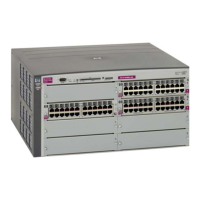Port-based Network Access and traffic control 40
The following figure shows a typical message exchange initiated by the client.
Figure 2 Using EAPoL to authenticate a port
EAPoL Message Exchange
During authentication, EAPOL messages are exchanged between the client and the switch authenticator, while
RADIUS-EAP messages are exchanged between the switch authenticator and the Radius authentication server.
Authentication is initiated by one of the following methods:
Switch authenticator sends an EAP-Request/Identity packet to the client.
Client sends an EAPOL-Start frame to the switch authenticator, which responds with an EAP-Request/Identity frame.
The client confirms its identity by sending an EAP-Response/Identity frame to the switch authenticator, which forwards
the frame encapsulated in a RADIUS packet to the server.
The Radius server chooses an EAP-supported authentication algorithm to verify the client’s identity, and sends an EAP-
Request packet to the client via the switch authenticator. The client then replies to the Radius server with an EAP-
Response containing its credentials.
Upon a successful authentication of the client by the server, the 802.1x-controlled port transitions from unauthorized
to authorized state, and the client is allowed full access to services through the controlled port. When the client later
sends an EAPOL-Logoff message to the switch authenticator, the port transitions from authorized to unauthorized state.
If a client that does not support 802.1x connects to an 802.1x-controlled port, the switch authenticator requests the
client's identity when it detects a change in the operational state of the port. The client does not respond to the
request, and the port remains in the unauthorized state.
NOTE: When an 802.1x-enabled client connects to a port that is not 802.1x-controlled, the client initiates the
authentication process by sending an EAPOL-Start frame. When no response is received, the client retransmits
the request for a fixed number of times. If no response is received, the client assumes the port is in authorized
state, and begins sending frames, even if the port is unauthorized.
